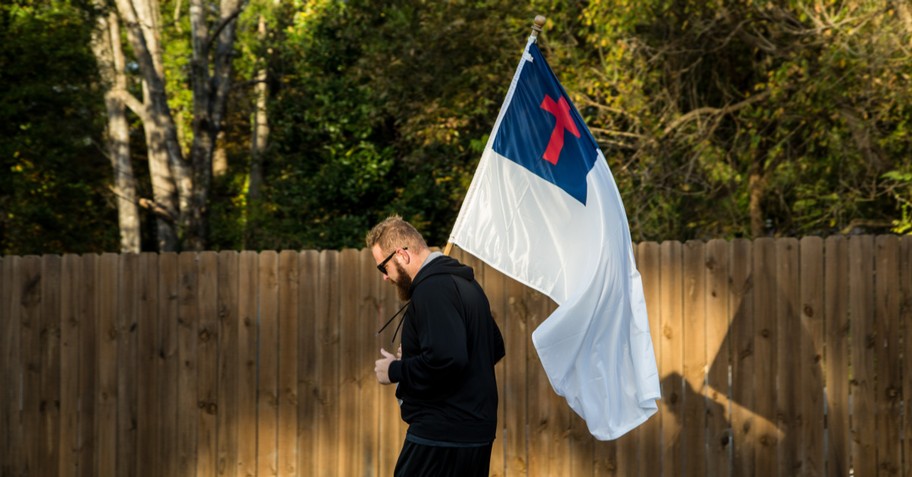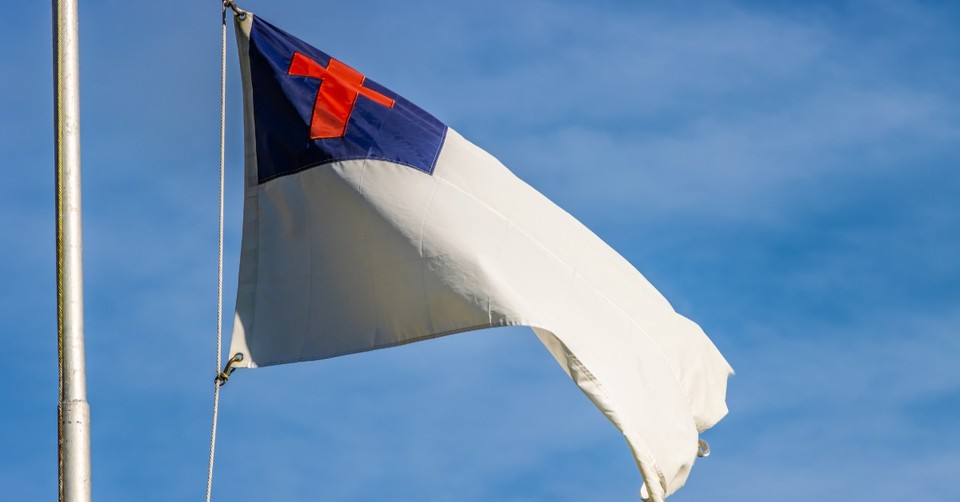When we joined our small rural mountain community church, one of the first things I noticed at the front of the church was the American flag on one side of the pulpit, and on the other side was the Christian flag. I don’t remember seeing the Christian flag in previous churches that I attended. Does your church fly the Christian flag? Let’s learn something about its significance.
Photo Credit: ©GettyImages/Ajax9
What Is the Origin of the Christian Flag?
History shows that the first idea for a Christian Flag was on September 26, 1897, at Brighton Chapel on Coney Island in Brooklyn, New York. Charles C. Overton, the administrator of the Sunday school, was the improvised speaker as the planned speaker never arrived. Overton asked the students what a flag representing Christianity would look like. Later, reflecting on their answers, he and Ralph Diffendorfer, secretary of the Methodist Young People's Missionary Movement, created the current design in 1907 and began promoting the flag.
The Christian flag is an ecumenical flag that was designed to represent much of Christianity and Christendom. In 1909, The Christian Advocate, a weekly newspaper published by the Methodist Episcopal Church, wrote an article about the origin of the flag. Excerpts from that article give us an insight into what the designers had in mind.
“Within recent years (1897) a flag has been designed which shall stand as an emblem . . . which all Christian nations and various denominations may rally in allegiance and devotion. This banner is called the Christian flag. The flag is most symbolic. The ground is white, representing peace, purity, and innocence. In the upper corner is a blue square, the color of the unclouded sky, emblematic of heaven, the home of the Christian; also a symbol of faith, trust, [and some say the waters of baptism]. In the center of the blue is the cross, the ensign and chosen symbol of Christianity: the cross is red, typical of Christ’s blood. The use of the national flag in Christian churches has become almost universal throughout the world.”
The flag created by Charles C. Overton and Ralph Eugene Diffendorfer was officially adopted on January 23, 1942, by the Federal Council of Churches of Christ in America, an ecumenical association of Christian denominations in the United States (now succeeded by the National Council of Churches and Christian Churches Together), 45 years after its unofficial use in 1897. The Christian flag initially represented the Anglican, Baptist, Eastern Orthodox, Lutheran, Methodist, Mennonite Moravian, Oriental Orthodox, Polish National Catholic, Presbyterian, and Reformed traditions of Christianity that merged with other ecumenical bodies in 1950 to form the National Council of Churches.
Today, it would be hard to find much agreement of doctrine and social issues even in ecumenical denominations, but the significance of the Christian flag remains. The red, white, and blue colors are also the same colors in the American flag.
Christian missionaries spread the Christian flag throughout the world, especially in Latin America and Africa and it’s even embraced by some Protestant churches in Europe and Asia. As Ralph Diffendorfer wanted, “Anyone may manufacture it [the Christian flag], and it may be used on all proper occasions.”
The Christian flag intentionally has no copyright or trademark rights as the creators wanted it to be used freely by all of Christendom. Fanny Crosby even wrote the words to a hymn called “The Christian Flag” with music by R. Huntington Woodman. The song, like the flag, is not copyrighted. On September 26, 2023, the flag will celebrate its 126th anniversary.

What Is the Pledge for the Christian Flag?
Even though our church has a Christian flag, I don’t remember us ever saying a pledge to it nor did I know that one existed, but it does. Actually, there are two versions. The first pledge was written by Lynn Harold Hough, a Methodist minister who had heard Ralph Diffendorfer promoting the use of the Christian flag at a rally. Hough composed the following pledge, somewhat with a similar pattern as the Pledge of Allegiance to the American flag, but shorter:
“I pledge allegiance to the Christian flag and to the Savior for whose kingdom it stands; one brotherhood, uniting all mankind in service and in love.”
More conservative evangelical, Lutheran, and Baptist churches and Christian schools or organizations might have a different pledge as follows:
“I pledge allegiance to the Christian flag, and to the Savior for whose Kingdom it stands; one Savior, crucified, risen, and coming again with life and liberty to all who believe.”
Some VBS programs, Christian schools, and churches start the morning with the Pledge of Allegiance to the American flag, the Christian flag, and there is even a Pledge to the Bible based on Psalm 119.
“I pledge allegiance to the Bible, God’s Holy Word, I will make it a lamp unto my feet and a light unto my path and will hide its words in my heart that I might not sin against God.”
Allegiance is defined as the loyalty owed by a subject to his or her sovereign. Synonyms for allegiance are loyalty, commitment, adherence, faithfulness, and duty. As American Christians, we pledge our allegiance to our country with the American Flag, our God with the Christian Flag, and our Bible, the Word of God.
“And now, Israel, what does the Lord your God require of you? He requires only that you fear the Lord your God, and live in a way that pleases him, and love him and serve him with all your heart and soul. And you must always obey the Lord’s commands and decrees that I am giving you today for your own good.” Deut. 10:12-13 NLT
Photo Credit: ©GettyImages/roberthyrons
Why Should We Care about the Christian Flag?
I did a survey on social media asking how many churches have a Christian flag in their sanctuary. The response was that a little over half do and half don’t and of the ones that do, several like the Lutheran Church, say all three pledges in their Sunday services.
One friend who teaches at a Christian school K-12 said they do fly both the American and Christian flags and say a pledge to both of them every school morning along with the Pledge to the Bible. What an awesome way to start the day for the children.
Today, there seems to be a flag for every organization and group that we can either agree with or disagree with and ignore. But the Christian Flag is a visual reminder of who we should devote our allegiance to as Christians who profess to put God first in our life as we pray he would be returned to first place in our country.
For years, my husband and I have had a replica of the American flag on our deck and also a seasonal flag flying that represents our Christian and biblical beliefs. I was asked once by a neighbor why we flew the flags with a Christian message and my response was that we wanted people driving by our house or visitors to know that Christians live in this home and also to be a welcoming encouragement to those observing it.
May we shout for joy when we hear of your victory and raise a victory banner in the name of our God. May the Lord answer all your prayers. Psalm 20:5 NLT

Our Spiritual Allegiance Is to God Alone!
As Commander-in-chief of the Continental Army in October 1775, George Washington had a flag designed which featured a pine tree with the motto "An Appeal to Heaven," or less frequently, "An Appeal to God." It was originally used by a squadron of six frigates that were commissioned under George Washington's authority. I’ve heard this flag referred to as George Washington’s humility flag as he knew the real authority came from God and wanted his troops to be reminded to honor God first.
The phrase “An Appeal to Heaven” was used during the crucial early years of the great Colonial experiment that became the United States. George Washington believed God would bring aid to the struggling nation as they strove for independence. His choice of the flag emblazoned with “An Appeal to Heaven” gave inspiration and hope to his troops when it looked like there was little chance of victory.
As loyal Americans, we protect and take pride in our United States of America flag, even when we don’t see our country always honoring the phrase of the pledge “one nation under God.” But like Washington’s “An Appeal to Heaven” flag, the Christian flag reminds us who we put our faith and trust in daily in all circumstances. As Christians, we humbly profess to live under the authority of God and his Word, the Bible.
Jim Elliot wrote, "In reading the Scriptures, I find a great moral power. Therein am I made aware of two great forces for good in human experience: the "fear" of God and the "grace" of God. Without the fear of God, I should not stop at doing evil; the fear of God restrains from evil. Without the grace of God, I should have no desire to approach positive goodness. The one is a deterrent from evil; the other an encouragement to good."
All you people of the world, everyone who lives on the earth—when I raise my battle flag on the mountain, look! When I blow the ram’s horn, listen! For the Lord has told me this: “I will watch quietly from my dwelling place—as quietly as the heat rises on a summer day, or as the morning dew forms during the harvest.” Isaiah 18:3-4 NLT
Jesus replied, “‘You must love the Lord your God with all your heart, all your soul, and all your mind.’ This is the first and greatest commandment. Matthew 22:37-38
Photo Credit: Phil Thep/Unsplash
Originally published July 06, 2023.








